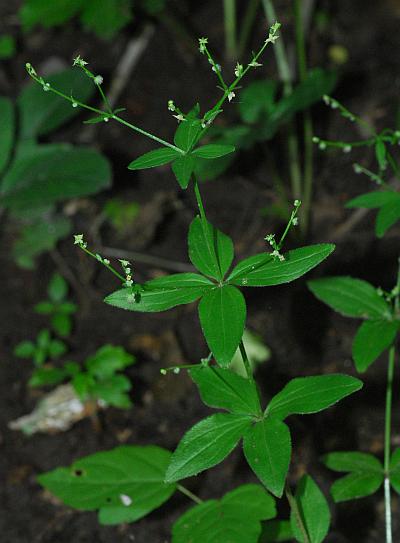Galium circaezans Michx.
Forest Bedstraw

Native
CC = 4
CW = 5
MOC = 78
© SRTurner
Galium circaezans Michx.Forest Bedstraw | |
 |
Native CC = 4 CW = 5 MOC = 78 |
© SRTurner |
|
Family - Rubiaceae Habit - Perennial forb. Stem - Ascending or erect, to 50 cm, sometimes from a spreading base, 4-angled, glabrous or moderately to densely pubescent on and between the angles with fine, straight, soft, spreading to somewhat upward-curved hairs.
Leaves - In whorls of 4 per node, spreading in orientation, simple, sessile. Blades 5-42 mm long, 2-22 mm wide, elliptic to ovate or lanceolate, angled to a bluntly or less commonly sharply pointed tip, angled to somewhat rounded at the base, the undersurface with impressed, linear glands (appearing as small streaks or lines), otherwise glabrous or with short, fine to stiff, straight hairs, the venation palmate with 3 veins visible, the margins flat, with short, stiff, prickly hairs.
Inflorescence - Terminal and sometimes also axillary from the upper leaves, positioned over the leaves, consisting of small open panicles (1-4 cm long) with mostly 1-3 branch points, or reduced and appearing as unbranched spikes, the branches very short to relatively long, mostly spreading.
Flowers - Sessile. Calyces essentially absent, occasionally represented by a minute rim at the flower base. Corollas 1.0-1.5 mm long, with a minute tube, deeply 4-lobed, the lobes spreading, not overlapping in bud, pale yellowish green. Stamens 4, attached in the corolla tube, the anthers exserted. Style 2-lobed, the stigmas 2, capitate. Ovary inferior, 2-locular, the ovules 1 per locule.
Fruits - Small schizocarps, 2-3 mm long, 3.5-4.0 mm wide, 2-lobed, dry, glabrous to tuberculate, the surface densely pubescent with short (ca. 1 mm long), hooked hairs, separating into 2 indehiscent mericarps at maturity.
Flowering - May - July. Habitat - Forests, bluffs, sinkhole ponds, glades, prairies, streambanks. Origin - Native to the U.S. Lookalikes - Other species of Galium, especially G. pilosum. Other info. - This inconspicuous plant with tiny flowers is found in good-quality woodlands across Missouri. Its wider distribution encompasses most of the eastern continental U.S. and parts of eastern Canada. Photographs taken at Onondaga Cave State Park, Crawford County, MO, 6-9-2014, and at Glassberg Conservation Area, Jefferson County, MO, 5-26-2017 (SRTurner). |